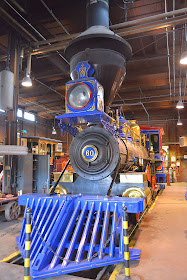I've always felt like we were kind of special because we lived in Utah, where the two sides of the Transcontinental Railroad met. But I'd never actually been to Promontory Summit where the last spike was driven. So I was happy to have this opportunity to finally visit the
Golden Spike National Historic Site!
We postponed our trip for what was supposed to be a warm(er) day, but when the day came, it was cold and windy! As it was our last free day for some time, we decided to brave the elements and go anyway. The last half hour of the drive was beautiful, through rocky, desert-y country like this:
It was interesting to think about how wild and untameable it must have seemed to people crossing it for the first time by rail! The picture above shows a cutting near Promontory Summit---you can see the chisel marks in the rock, and the stacks of cut rock on top of the hill.
Here you can see a huge embankment the railroad workers built up to cross a low-lying area. First, they tried a (hastily and badly-built) trestle to cross the area, but it was a hazard, and they eventually replaced it with this fill instead. It must have been an enormous undertaking!
Because it is not the summer season, the locomotives (replicas of the original
Jupiter and
119 locomotives) were being worked on in the engine house. Starting in May, there are re-enactments of the Golden Spike ceremony and they
run the steam locomotives, which we would like to see sometime. But we enjoyed being able to look at everything up close in the engine house, and being there off-season meant we had everything to ourselves (a private tour!) so we quite liked it anyway. It was fascinating to see all the workings of the engines up close. Everything looks so powerful---even when it's not running!
We enjoyed turning this little model and watching how the steam pushes the pistons, which push the driving rods and turn the wheels.
The details are beautifully done on the locomotives---the 119 had these lovely little pictures on its corners
Huge driving wheels
Seb was really fascinated with this enormous piston
The park ranger that gave us the Engine House tour was really nice, and back at the Visitor's Center (the Engine House is just across a field from it) they had some good movies for us to watch, including Thomas Edison's "The Great Train Robbery." There's also a small museum area, which we liked.
Coupling pin
This display showed all the steps involved in making the railroad, from surveying to hammering in the ties.
Outside, we stood on this section of original rail while almost getting blown away. It was REALLY windy! (Look at Daisy's hair!) Junie, immediately upon setting foot outside the door, felt the strong wind and started crying. She thought she was going to blow away.
It gave us quite a thrill to see the spot, the very spot, where this photograph was taken---the meeting point of the two rail lines.

We re-enacted the historic handshake.
You can see the telegraph lines where they sent the message to the nation that the railroad was finally complete!
The golden spikes, of course, were never left on the rails in the first place, and the special laurelwood tie had to be removed and replaced also. But you can see the gouges (above) in many of the surrounding ties, where people hacked out souvenirs to take home from the ceremony.
And Sebby presents . . . the Transcontinental Railroad!
On our way out of the area, we drove on a couple of scenic routes to see some cuttings and embankments done nearby. We also stopped at the "Chinese Arch," which is named for the Chinese Railroad Workers. It's a naturally-formed arch, but it doesn't look like it with that squared-off underside! Very interesting.
We really liked this field trip in spite of the cold and windy day, and in spite of
all of us forgetting it was St. Patrick's Day and realizing to our horror that none of us had worn green! *gasp* That has never happened before. We had to eat our picnic lunch in the car, but luckily we found a great place to do it, on the main road just a half mile past where you turn to get to Golden Spike National Monument. It was
something we never expected to see out there in the middle of nowhere . . . but it will have to wait for another post! :)
























































